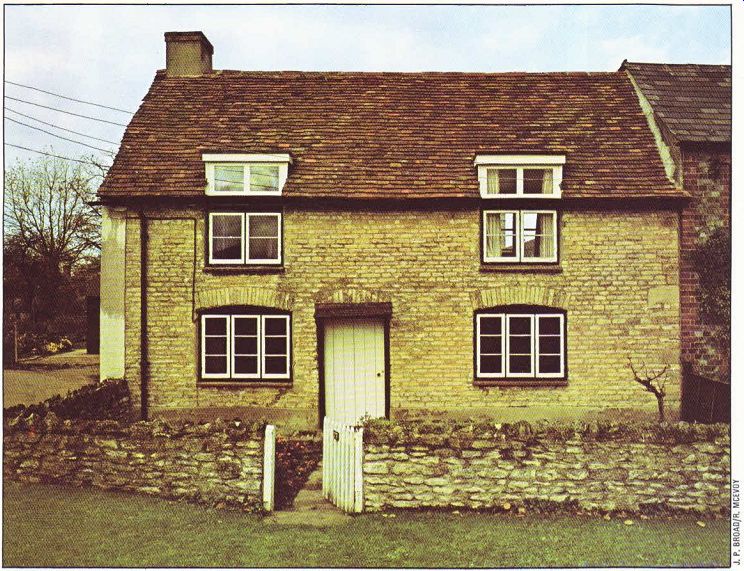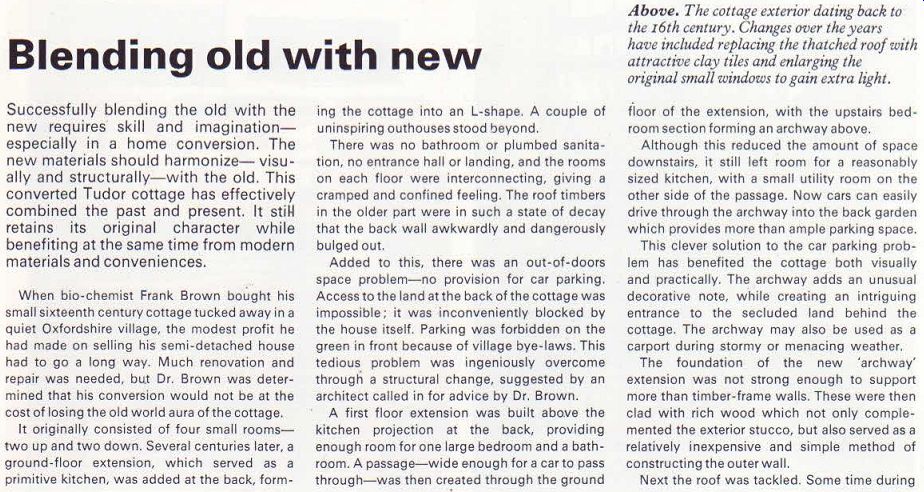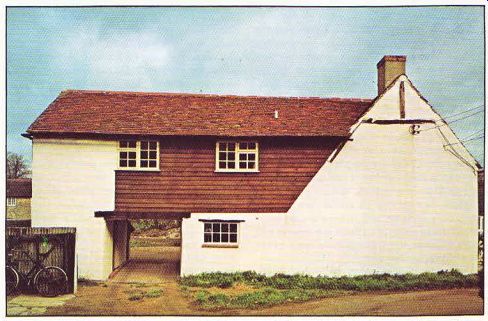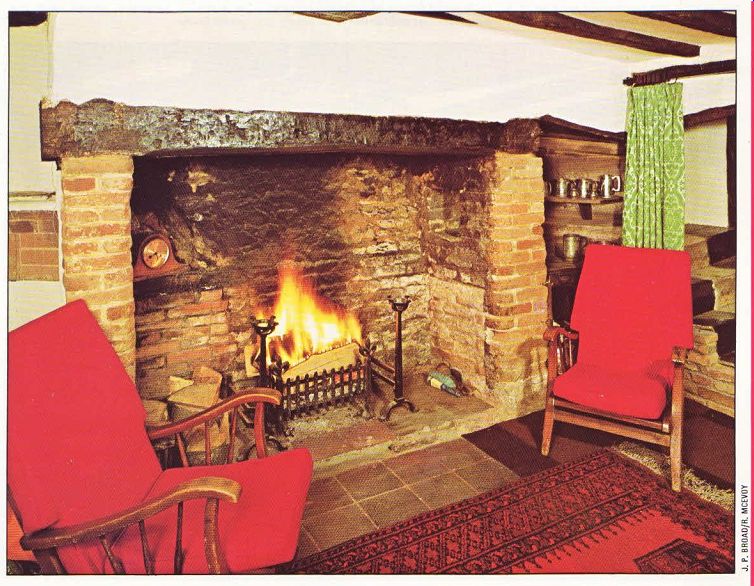

[…] the last century, the thatch on the older part of the house was replaced
with tiles. Similar tiles had been used for the newer kitchen projection and,
fortunately, these could be re-cycled for the roof on the 'archway' extension.
The choice of roof material was a good one. By using similar tiles on both the old and newer parts of the cottage, a visual continuity was achieved. The extension, rather than looking as a ‘stuck-on' afterthought, seems to emerge as an integral part of the house.
Dr. Brown worked together with his friends on the replacement of tiles in the new section.
Before attempting the job, however, he called in a professional builder to give guidance in re doing the roof timbers on the older section. This combination of professional and amateur effort is often a good compromise if you're working on a slim budget. The professional specifies and guides, while the amateur does the main bulk of physical labor. It may cause slight backache, but you'll see greater results for your money.
Other changes, which helped to brighten up the cottage, evolved out of the new roof in the old part. The pokey front windows were heightened to make graceful dormer windows.
Further light was allowed to spill into the up stairs by building generous French windows, offset by a balcony, for the main bedroom.

------- Above. Side view of the cottage showing the later extension.
The unusual archway adds an interesting visual touch as well as allowing cars
to drive into the back garden where there is ample parking space.

---------ABOVE. The imposing fireplace, with its original cross beam,
serves as a handsome focal point for the living room. The bricks retain warmth
from the ire and act as a giant storage heater for the cottage.
An effort was made to keep the character of the house wherever possible. The existing purlins in the old section, for instance, were left exposed, although they don't provide the true support which comes from the new purlins hidden behind. The other old roof timbers were replaced, but still put to good use elsewhere for internal construction. After being treated for woodworm, the old timber was used in one room, for example, as cross beams between the purlins to support the plaster board ceiling, Early investigations in the old section showed that there were a number of beams in the walls and ceilings downstairs which had been plastered over during an earlier ‘renovation'.
This is quite common with houses of this period and, although uncovering them is a tedious and messy business, it is well worth the result of the added character they give.
Another discovered feature, uncovered by Dr. Brown, was the magnificent central fireplace. It had been bricked up in the past when smaller fireplaces were in vogue. Using a cold chisel, a wide stone fireplace with an imposing heavy beam above and a bread oven to one side was revealed.
The bread oven, which was in poor condition, was removed and then concentration centered on cleaning up and restoring the fireplace. Once this laborious task was finished and a fire lit, a new problem arose. Heavy, dark smoke poured into the room, creating an intolerable atmosphere. As an experiment, the pot was removed from the chimney and, fortunately, this eliminated the unwanted smoke. When the fire is used on a regular basis, the bricks in the wide chimney become warm and act as a giant storage heater for the house.
Once the large fireplace was exposed, it tended to dominate the small room which also formed the main thoroughfare of the house.
Consideration was then given to opening out the room by knocking down the existing partition between the two downstairs rooms.
Investigation showed that, although it was essentially load-bearing, by putting a large vertical beam in the middle under the heavy existing cross beam at ceiling level, the wall could be safely removed.
The new beam was treated' to make it blend with the other decor. First it was stained to make it look older and then the corners were chamfered. Now the 'new' beam not only serves as a functional item, but also as an attractive feature in the spacious room.

------- ABOVE. A dining area rich in color and atmosphere. The heavy
Jacobean-style table and straight-back chairs in dark oak contrast with the
white walls. The ceiling beams add to the period flavor, while the rich red
gives a dramatic note and warmth to the decor.
Obviously the furniture in the room couldn't be modern in style if the period look was to be maintained. Instead, heavy and imposing Jacobean-style table and high-back chairs in dark oak were chosen. Further chests, tables and book cases also follow the Jacobean motif.
If you're interested in getting old world style into your home, there are many interesting and ex citing ways of introducing a period touch through imaginative interior design. A single piece of antique furniture, for instance, can add a great deal of charm to a room, giving it new character or style.
As a foil for the dark wood, the walls were painted in white emulsion, to which a small amount of brown was added to lessen the glare.
An inexpensive and hard-wearing floor covering-carpet tiles-in a rich brown were put down. The tiles have the advantage of reducing waste when they are fitted wall-to-wall and they can be rotated to distribute the wear evenly. A bold splash of color comes from a fireside rug and chair upholstery in rich red-a popular Jacobean color.
The ultimate mood of the cottage is one of old world comfort and charm. The warmth of the fireplace and the richness of the beams and rafters add to the overall effect. It‘s a superb example of how modern materials can be used in a cottage conversion without losing the period flavor.